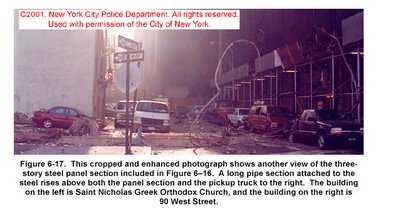Speed Calculations for the Immaculate Wheel
This guy:

Using some simple formulas from this page, at the "Horizontal Launch" section, we can calculate the exit velocity from the building and the velocity at time of impact, if we put in the height this set of columns were "launched" from and the distance they traveled.
Using 500 feet as distance traveled (R) and 1162 feet as the height (h = the height of the 94th floor), I got 40 mph as the exit velocity and 186 mph as the impact velocity.
40 mph tends to favor the official story and shows that because of the extreme height, relatively modest velocities can propel the columns quite some ways (independent of their weight, by the way*).
The impact velocity on the other hand, 186 mph, still raises the questions of how these 12,0000 pound columns didn't damage the pavement and also how the wheel managed to survive that impact without getting dislodged.
*The amount of force required to dislodge these columns AND propel them to 40 mph is another issue. It's certainly not an insignificant force, but not out of the realm of comprehension for a major explosive event.

Using some simple formulas from this page, at the "Horizontal Launch" section, we can calculate the exit velocity from the building and the velocity at time of impact, if we put in the height this set of columns were "launched" from and the distance they traveled.
Using 500 feet as distance traveled (R) and 1162 feet as the height (h = the height of the 94th floor), I got 40 mph as the exit velocity and 186 mph as the impact velocity.
40 mph tends to favor the official story and shows that because of the extreme height, relatively modest velocities can propel the columns quite some ways (independent of their weight, by the way*).
The impact velocity on the other hand, 186 mph, still raises the questions of how these 12,0000 pound columns didn't damage the pavement and also how the wheel managed to survive that impact without getting dislodged.
*The amount of force required to dislodge these columns AND propel them to 40 mph is another issue. It's certainly not an insignificant force, but not out of the realm of comprehension for a major explosive event.


7 Comments:
a 7ton steel is travelling 186mph when it hits a 3" thick pavement and/or a 4" thick sidewalk and does no damage to either?
good thing it wasn't made of an aluminum tube with a plastic nosecone or it might've plunged all the way into that poor parking lot like a lawndart!
the magic of 9/11.
Thanks, Spooked. That might explain why they put it where they did--at least the distance sounds plausible.
I still don't think the panel is authentic because I don't see how you the debris overcomes both the connections between this module and surrounding modules and the inertia of the panel and gets it moving at 40 mph. Inertia (resistance to changes in state of motion) is a function of mass, and this sucker weighs 6 tonnes. (It doesn't look that heavy to me---does it to you?)
I also don't believe that debris exited the building at all after passing at a downward trajectory through the core. I will try to do some rough comparisons with WTC2, where debris had a higher initial velocity and did not pass through the core.
But the best way to rule it out might be to show the amount of kinetic energy that would be required to get that module up to 40 mph.
If I can figure out how to do it, I will start with what I think is a hugely generous assumption that 10,000 pounds of debris hit the panel at 150 mph on a horizontal trajectory. Would that dislodge the module panel and get it moving at 40 mph? This might depend on knowing how strong the connections between the panels were. Bolted? Welded? Both?
That's a tough calculation, Ningen, but I think you're on the right track. Something would have to hit that panel damn hard to both dislodge it and get it moving 40 mph-- and it sure wasn't that ridiculous tire!
I think the columns-- assuming they are real-- could be 6 tons. There's a lot of steel there.
"good thing it wasn't made of an aluminum tube with a plastic nosecone or it might've plunged all the way into that poor parking lot like a lawndart!"
Indeed! Might have gone all the way in the ground like flight 93-- and THEN where would we be?
Maybe I could do less weight and forget the connections.
I question whether the connections between the modules are weaker than the wall formed by the modules. If the connections were weaker, it seems that the plane holes would have been consisted of modules that gave way, not holes through modules.
Not that the holes were formed by planes.
Hmm, on second thought, the modules are backed by the floors when the impact is into the building. They might not break at the connections or it might not be obvious that they had.
the connections between one steel and another (welds AND bolts) are always (requirement!) stronger than the steel itself.
the steel of the wtc would break in the middle of a length of box column before it would break at a join of 2 columns.
Post a Comment
<< Home